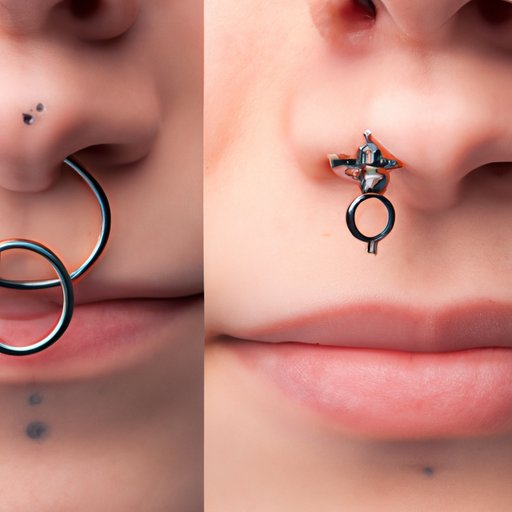
Introduction
Nowadays, people follow their own fashion sense and style, and piercing is considered one of the most popular body modifications. While there are various types of piercings available, nose piercing, in particular, is the most popular. From the modest stud to the elaborate septum ring, nose piercings are widely accepted and loved by people around the world. In this article, we will provide a comprehensive guide on nose piercing that covers the different types of piercings, the piercing process, aftercare, pros and cons, personal experiences, and how to find a reputable piercer.
Different Piercing Options
There are three main types of nose piercings – nostril, septum, and bridge piercing, and all of them have different placements, healing times, and jewelry options.
Nostril piercing: is the most common type of nose piercing and can be placed on any side of the nostril. Nostril piercing is suitable for smaller jewelry and heals within four to six weeks.
Septum piercing: is done on the thin tissue that separates both nostrils. Septum piercing is typically done with a needle, and once healed, the jewelry can be flipped up or down to give a cleaner look. The healing time for septum piercing is generally six to eight weeks.
Bridge piercing: is placed on the bridge of the nose between the eyes. It is a more complicated piercing since it goes through a thicker part of the nose. Healing time for bridge piercing is typically eight to twelve weeks.
Step-by-step Guide for Nose Piercing
Before beginning the piercing process, the piercer will first make sure that the area is clean and free of infection. Sterilized tools and jewelry will also be used for the procedure. Throughout the piercing process, the piercer will use gloves to avoid contamination. Below are the necessary steps involved in the piercing process:
Nostril Piercing:
- The piercer will mark the surface of the nostril with a surgical pen, indicating the point for the piercing to be placed.
- The piercer uses a sterilized needle to make a small hole in the marked area.
- The piercer will then insert a sterilized stud ring or stud earring and secure it in place with a backing or screw-on ball.
Septum Piercing:
- The piercer will use a surgical pen to mark the area to be pierced. It usually can be found in a sweet spot in the center of the soft tissue.
- The piercer will then use a sterilized septum clamp to hold the area in place.
- The piercer will insert a sterilized needle through the marked spot.
- Once the needle is through the piercing area, the piercer will insert a sterilized ring, horseshoe or circular barbell through the hole. The jewelry must be flipped up to keep it secure and aid the healing process.
Bridge piercing:
- The piercer will mark the spot where the bridge piercing will be located.
- The piercer will then use a sterilized needle to create holes in the marked area.
- Once the needle is through the piercing area, the piercer will insert a sterilized barbell.
Aftercare Instructions
Aftercare is vital to keep the piercing clean and speed up the healing process. Proper aftercare can also prevent infections or scarring. Below are some general aftercare instructions:
- Clean the piercing daily with soap and water.
- Soak the piercing with a saline solution.
- Avoid touching the piercing with unclean hands.
- Avoid taking a bath or swimming pool.
- Avoid using makeup or perfumes near the piercing area.
- Always use sterilized tools when changing the jewelry.
Pros and Cons of Nose Piercing
Nose piercing can be a pretty fun and creative way to showcase your style and personality. Here are some pros and cons of nose piercing:
Pros:
- Enhance your facial features.
- Create a unique and personal style.
- A wide variety of jewelry options are available.
Cons:
- There might be a risk of allergies and infections.
- Healing time may take longer than other types of piercings.
- There is a chance of scarring if not taken good care of.
Experience
The decision to get one’s nose pierced can be overwhelming, and figuring out the details such as what type of piercing, jewelry, and aftercare can seem like a lot. It is essential to understand your pain tolerance before attempting to go through with the piercing. The process itself is usually reasonably quick, and aftercare diligence can ensure a speedy recovery. However, potential pierce enthusiasts should consider their profession, any reaction they might have, and what their parents think before finally putting a hole in their nose.
Finding a Reputable Piercer
When it comes to body modifications, safety, and hygiene should always be a top priority. Here are some tips to find a reputable piercing studio:
- Ask for referrals from trusted friends or family members.
- Check online reviews and ratings of the piercer.
- Make sure the studio follows appropriate hygiene practices by sterilizing their instruments after each use.
- Ensure that the piercer is licensed and certified.
- Asking questions like what kind of sterilization techniques, piercing technique and steps, potential risks, what to look out for, and other aftercare questions.
Conclusion
Nose piercing is an excellent way to express your style and enhance your facial features. It can undoubtedly be a fun and thrilling experience. However, potential pierce enthusiasts need to weigh the pros and cons of getting a nose piercing before going through with it. Once decided, it is critical to find a reputable piercer and follow proper aftercare steps to keep the piercing clean and prevent infections. Remember to take care and clean your nose piercing daily, follow through, and avoid touching the jewelry with unclean hands.




